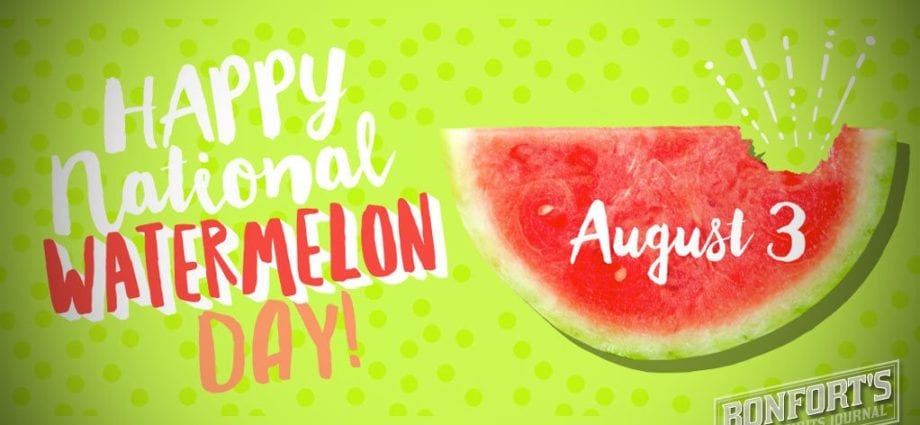A delicious holiday is celebrated in different countries on August 3 – Watermelon day (Watermelon Day).
Its history comes from the USA, where it is celebrated as National Watermelon Day. America ranks first in the number of eaten watermelons compared to other countries. Here, this sweet and tasty fruit (or rather, a berry) is just as essential for summer picnics as it is.
Perfectly quenching thirst and being completely low in calories, watermelon, of course, deserved its own holiday. Although it is not known who installed it and when, it does not lose its popularity because of this, gaining more and more supporters every year. Therefore, today we can say with confidence that the holiday has become international.
By the way, in the United States, watermelons are very popular, especially, as studies show, among the Latin American part of the country’s population. And how not to love him: huge, sweet, refreshing, he turns any meal into a real holiday.
According to the dictionaries, the common watermelon (lat.Citrullus lanatus) is a melon crop, an annual herb, a species of the genus Watermelon (Citrullus) of the Pumpkin family (Cucurbitaceae). The color of the bark of watermelon is different: from white and yellow to dark green with a pattern in the form of a grid, stripes, spots. And the pulp is pink, red, crimson, less often white and yellow. By structure, watermelon is considered a berry, and is currently grown in 96 countries of the world in more than 1200 varieties.
According to historians, the homeland of watermelon is South Africa. It is known that already in Ancient Egypt people knew and cultivated this plant, which is confirmed by excavations. So, in the era of the Middle Kingdom in the 20th century BC. watermelons were often placed in the tombs of the pharaohs as a source of food in their afterlife (for example, seeds were found in the tomb of Tutankhamun).
In addition, the watermelon was depicted on the walls of tombs and was mentioned in ancient Egyptian myths and in many medical recipes of ancient papyri. It was also known in ancient Rome, where it was eaten fresh or salted, and honey was also brewed from it.
By the 10th century, watermelon was also known to the Chinese. He got to ancient China on merchant ships plying the Mediterranean Sea, and immediately became very revered (by the way, China still celebrates its Watermelon Day). In addition, the Chinese attached great medicinal value to watermelon, attributing to it the property “… to cleanse the body and take diseases out of the body, if taken constantly before meals.” And today more watermelons are grown in China than in any other country.
In Russia and Europe, watermelons first appeared around the 11-12 centuries (according to other sources – in the 13-14 centuries), and they were brought to America in the 16th century by European colonists, along with African slaves.
Today, watermelons are grown in almost all countries of the world, and most of all in China, followed by Turkey, Iran, Egypt, the countries of America, as well as Russia and Uzbekistan, with a noticeable lag.
But Japan has no equal in the number of the strangest varieties of watermelons – square watermelons, pyramid-shaped watermelons, watermelons with yellow flesh and watermelons-crumbs with a diameter of 10 cm were bred there.Watermelons are well cultivated in the steppe and Mediterranean climates with long hot dry summers and mild, short in winter.
It’s no secret that watermelons are not only tasty, but also a very healthy delicacy. It contains more than 90% water and only about 6% sugar from the total mass. Watermelon is an excellent source of vitamin A and contains a complex of B vitamins, vitamin C and folic acid. Watermelon is one of the leaders in the content of lycopene – a very powerful antioxidant. All this not only helps to strengthen the immune system, but also helps the body to maintain the normal function of the nervous system and the formation of red blood cells. In addition, the salts of iron, potassium, sodium, phosphorus, magnesium, contained in the pulp of watermelon, have a beneficial effect on the activity of the organs of hematopoiesis, digestion, cardiovascular system, endocrine glands.
Watermelon is used in medical nutrition for anemia, diseases of the cardiovascular system, diseases of the liver and urinary tract, it has a diuretic and choleretic effect, prevents the formation of stones in the gallbladder, helps to eliminate cholesterol from the body, and also helps to control the heart rate and regulates blood pressure. Watermelon juice quenches thirst well in case of fever. And, of course, watermelons can be used not only as a source of vitamins and minerals, but also as a tool to raise your mood.
In addition, a large number of different dishes can be prepared from watermelon. They are usually just eaten fresh, but they can also be used in desserts (such as fruit salads) and drinks, cooked or boiled. For example, in some regions, nardek (“watermelon honey”) is prepared from watermelon by evaporating the watermelon juice to the density of honey. By the way, watermelon crusts do not disappear either – it turns out that jam or pickle is made from them. So, the recipe for pickled watermelon peels was published in a cookbook published in America in 1796.
How is Watermelon Day celebrated? Of course, they arrange picnics in nature, where they eat a huge amount of watermelons, and then arrange competitions – who will spit a watermelon seed farthest, or a competition for the best figure carved from a watermelon.
If you also love this berry, join the celebration of Watermelon Day – eat it with friends outdoors, or at home, having delighted the children, arrange a competition for the best watermelon dish, prepare a refreshing one … The main thing is to enjoy this tasty and healthy delicacy!










